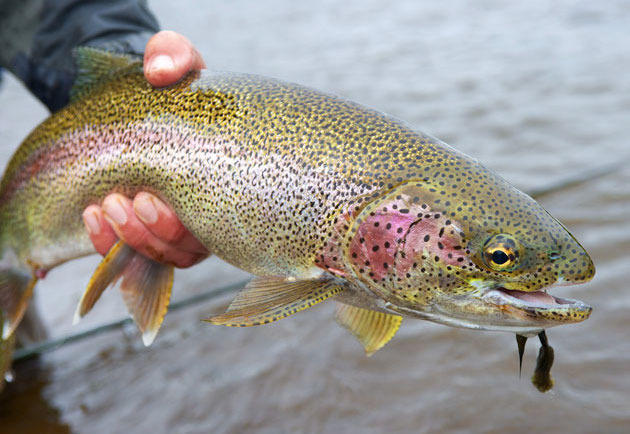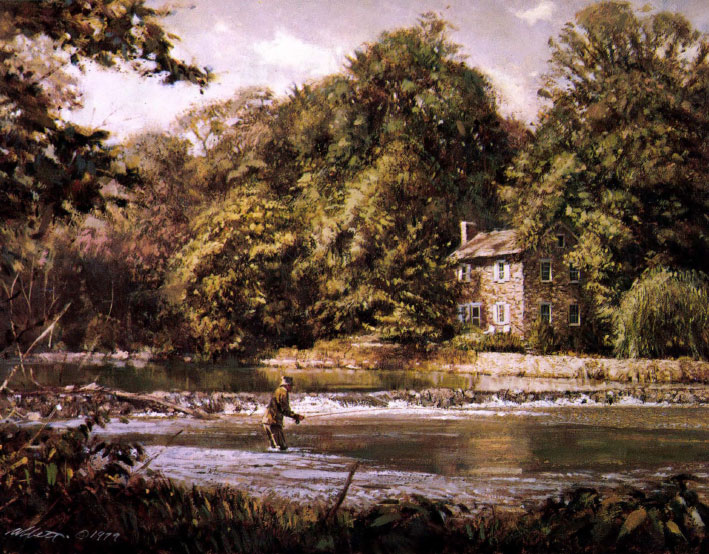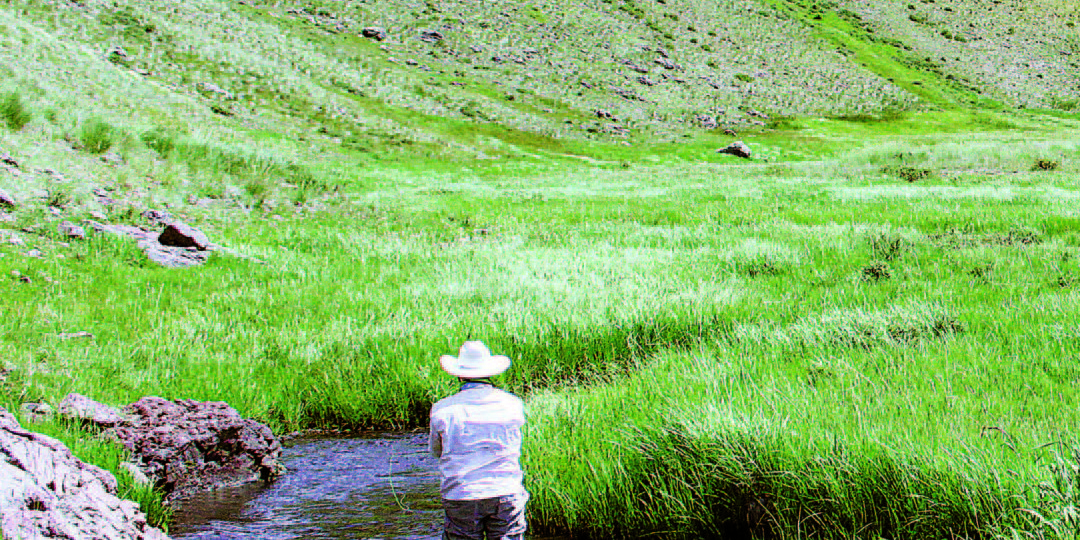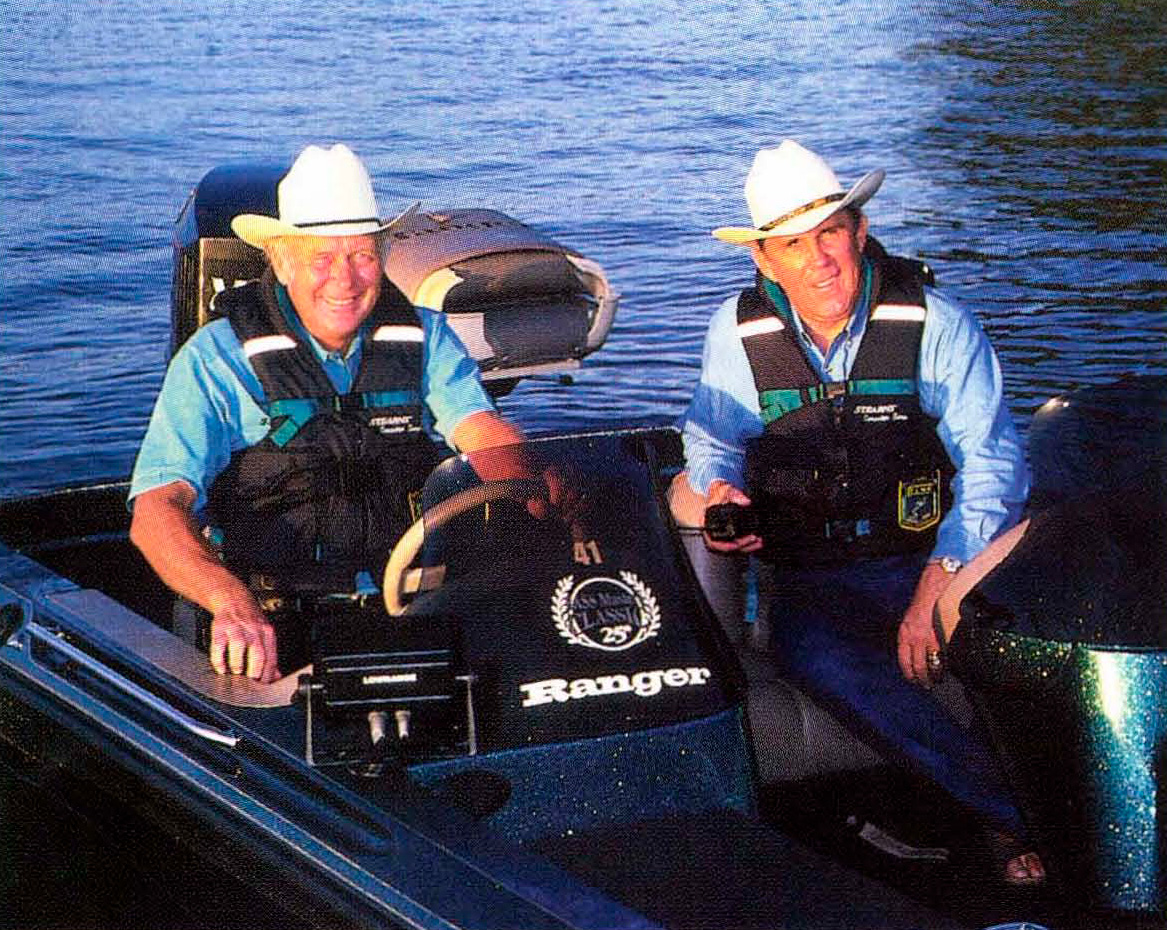When big rainbow trout are running upstream to gorge on salmon eggs,there are few more exciting places in the world to be carrying a fly rod than the Copper River. First, however, let’s get on the right water.
There are two Copper Rivers in Alaska (plus myriad Copper creeks, lakes and mountains). The big, glacial torrent famous as the source of Copper River salmon drains into Prince William Sound. A baby in comparison, the Copper River in Southwest Alaska (our Copper River) runs barely 40 miles from the Chigmit Mountains to Iliamna Lake, but it’s a clear, inviting trout stream all the way.
And in contrast to other great trout streams in this part of the world, the Copper can be spectacular when the first red salmon of the year are still way out in Bristol Bay. Chalk this up to a relative abundance of insect life in the streams on the south side of Iliamna Lake—not much by limestone spring creek standards, but plenty in a region where matching the hatch usually means picking the right salmon egg imitation. And in addition to the bugs, there are the mice. We’ll get to them later.
So it was one sunny day in early July a few years back when my wife, Lori, and I took a break from some chores at our friend Bob Cusack’s nearby lodge to explore the lower Copper with dry fly tackle. The stream looked oddly serene absent the salmon and the host of predators and scavengers they attract. Anticipating a quiet morning of fishing free from aroma of decaying salmon or distraction by cruising brown bears, I bellied into the current and dropped a Stimulator into the slot adjacent to the opposite bank. The tranquility didn’t last long.
I cannot explain the phenomenon whereby fish taken on dry flies appear larger than those of identical size hooked below the surface. The first rainbow of the morning looked to be about 24 inches long when it finally slid to the gravel bar 50 yards downstream from the point of attack. Only in Alaska do trout that size elicit ho-hums.
In the event, I couldn’t have been happier. A tape measure wouldn’t have added to the moment anyway, for Lori was already fast to a comparable rainbow of her own. It was time to catch fish, not measure them.
MONSTERS OF
THE LAKE

With nearly a thousand square miles of surface area, Iliamna Lake is large enough to constitute its own ecosystem. The base of the aquatic food chain arrives every summer as red (sockeye) salmon power their way up the Kvichak River and disperse throughout the lake, then move into its headwater streams to spawn. Resident gamefish, including big “lake anadromous” rainbows, depend on the salmon for their food supply—first their eggs, then their decaying flesh and finally their smolt. When any of the three are in the streams or in the Kvichak, the rainbows will be there too.
Of course, the salmon themselves offer rich fly fishing opportunities, as do the local grayling, char and pike. But the lake’s resident rainbows are clearly the featured attraction. The adjective big, as employed in the previous paragraph, means just that. In these waters, 30 inches is the gold standard for a rainbow that warrants comment; anything less is just another nice fish. That concept may require some attitude adjustment by anglers new to the area, but getting there is half the fun.
According to centuries worth of legend, those rainbows aren’t the only monsters prowling Iliamna waters. Oral tradition from several Alaska Native cultures describes terrifying fish-like creatures inhabiting the lake.
As bush pilots began to cross Iliamna regularly in the 1940s, they started reporting visual contact with mysterious “monsters” in the waters below. Many of these descriptions came from known, sober sources, and they were remarkably similar: 15 to 20 feet long, the color of aluminum. Such reports, though never objectively verified, continue today.
What might the Iliamna Lake monsters be? Nothing more tangible than Bigfoot or Nessie according to some, though the consistency of the descriptions from reliable observers suggests otherwise. Beluga whales sometimes travel up the Kvichak in pursuit of fish, and Iliamna Lake is home to one of the world’s few populations of freshwater seals. But the best bet may be white sturgeon. Although never documented to inhabit Iliamna, these fish do live nearby, attain the appropriate size and could remain hidden in the lake’s thousand-foot depths for long periods of time.
Personally, I’m hoping “Illie” turns out to be the world’s largest rainbow trout—and that someone catches it on a dry fly.
GATEWAY TO
THE PENINSULA
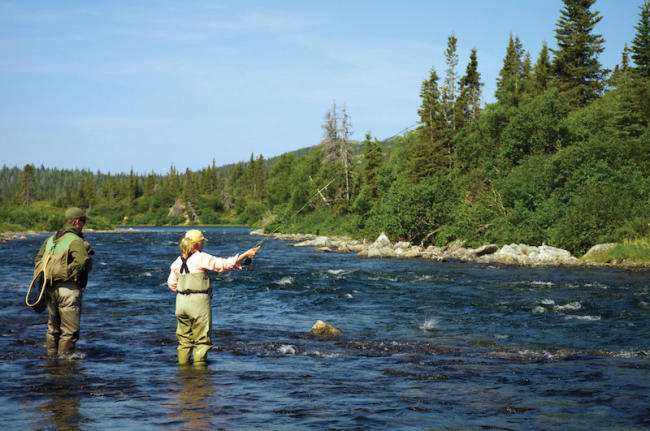
No fixed boundary demarcates the Alaska Peninsula from the rest of the state, but to me the line runs right up the middle of Iliamna Lake, from the mouth of the Kvichak to Pile Bay. Plenty of great fishing lies north of that line: Talarik Creek makes every short list of great Alaska trout streams, and I’ve floated the Koktuli and the Mulchatna more times than I can count.
This discussion, however, will focus on the southern side of Iliamna Lake, in what is some of my own favorite country, for several reasons. The peninsula, with its huge bears and spectacular volcanic terrain, always feels especially wild, even by Alaska standards. The threat of the Pebble Mine—and may the final stake have been driven through the heart of this grotesque project by the time you read this —lies on the other side of the lake. And because I’ve worked in the bush on the south side of Iliamna, I enjoy a feel for the area’s nuances that can only be earned by spending a lot of time there in a tent.
From the angler’s perspective, the two most important waters are the Copper River and the less well-known Gibraltar Lake drainage. Having enjoyed a taste of the first, let’s move on to the second. I know the Gibraltar system especially well, since I guided bear hunters there for several seasons. While that may not seem a typical way to learn a trout stream, some bear guides have been known to carry fly rods into camp to help pass the time between stalks and skinning chores. Imagine that.
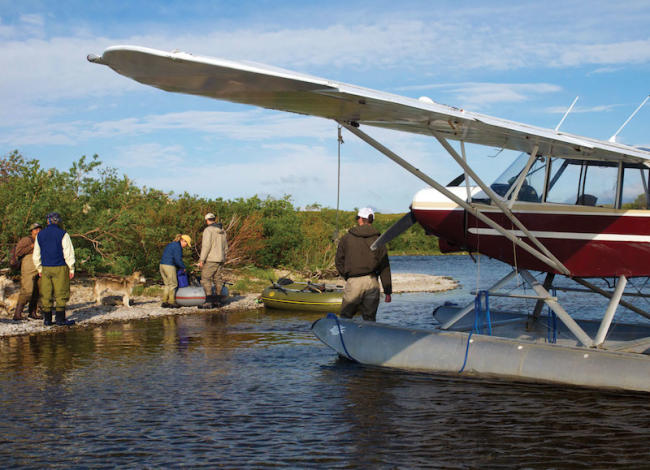
A day-float down the Gibraltar begins with a flight in by Super Cub.
The Gibraltar actually begins life as the aptly named Dream Creek, an uncommonly charming little trout stream that empties into the upper end of Gibraltar Lake. A clear, gentle series of riffles and pools no more than a roll-cast wide, Dream fills up with spawning red salmon every summer. The run persists longer than it does in many streams (well into October, which is later than most visitors will want to be there), and as long as the reds are there, the trout will be too. So will the bears.
Twelve miles of Gibraltar Lake separate the mouth of Dream Creek from the origin of the Gibraltar River, which runs through six miles of tundra to Iliamna Lake. Gibraltar River’s name is inaccurate in two respects: It exists nowhere officially, though that’s what everyone calls it, and it’s even less a “river” than the Copper. The Gibraltar definitely has its own personality compared to the Copper and Dream Creek. A steeper drop makes the current livelier and dense streamside brush makes it a bit trickier to fish. But its length and the presence of floatplane lakes at both ends make the Gibraltar a great day-float in inflatable rafts, and its rainbows, similar to those in the Copper, show enthusiasm for dry flies.
Don’t expect spring creek-style hatch charts here—the North’s aquatic insects are usually too unreliable for that. Alaska top-water fishing usually involves healthy measures of empiric observation and guesswork, as Lori and I demonstrated on the Gibraltar one gorgeous June day a few years back.
Friend and occasional employer Bob Cusack had dropped us off at the lake outlet with a little raft, and with the reds yet to arrive and the current still feeling its muscles from the last of the spring runoff, I expected a quick trip down to the lake without a lot of fishing.
We started off prospecting unsuccessfully with streamers, but then I noticed a trout holding beneath the overhanging willows on the far bank in what could only be a feeding position. A search through my vest revealed a stash of Elk-Hair Caddis patterns, which seemed as good a way to start as any. The current was so brisk that I had to hang on to Lori’s wading belt to stabilize her as she edged far enough from the brush along our bank to cast. The presentation required a quick series of mends, but she nailed the cast and the fish nailed the fly. The fish—the first of many that day—proved to be another, boring 25-inch rainbow. Sigh.
OF MICE & MEN . . .
& BEARS
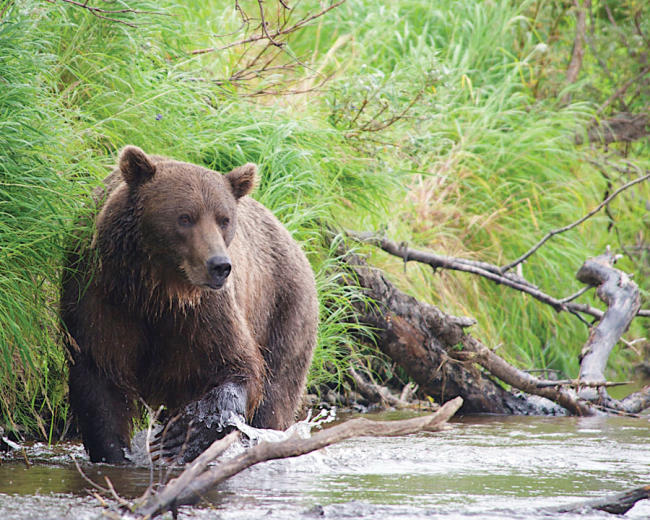
Although fewer and farther between, the mammalian wildlife on the Alaska Peninsula can be just as interesting as the fish, none more so than two varieties from opposite ends of the size spectrum: mice (small rodents of several related families) and brown bears.
The Alaska tundra is hungry country, and apex predators there routinely catch, kill and devour whatever sources of nutrition they can find. In the case of rainbow trout, this includes an assortment of mice, voles, shrews and any other animal small enough to fit in a trout’s mouth and stupid enough to swim in the water. The mouse hatch may lack the elegance of a blue-winged olive eruption, but nothing can rival it for excitement on a fly rod. The Copper and Gibraltar are great places to experience it.
Periodic migrations of voles can fill streams with targets for trout that feed on them selectively, but sometimes the angler simply has to tie on a big glob of deer hair and see if anything is interested in rodent sushi. Such was the case on the upper Copper one day when I blindly presented a mouse pattern to the current beneath an overhanging bank. In no time, I was in fish-every-cast territory. The trout weren’t huge, but their aggression was unbelievable. Even grayling tried to get their size 12 mouths around size 2 mice. Every angler who enjoys topwater fly fishing deserves such a day once in his or her career.
Then there are the bears. Spend time on any of these streams when the salmon are in and you are going to bounce off brown bears, often at close range and in large numbers. I spend a lot of time convincing visitors not to be terrified of these encounters, which contribute to the wilderness experience and virtually never end badly. That said, the closest I ever came to the exception was on the Copper.
Two friends and I had flown in to a lake and hiked down to the river. Within minutes of our arrival on a convenient gravel bar, I noticed a solitary young brown bear walking through the willows behind me. With nothing remarkable at all about the bear, I called out a routine heads-up to my partners and kept fishing.
But when the bear reached the end of the bar, instead of continuing in search of its next fish, he turned back in our direction. Since we were in plain sight and the bear was straight downwind, there could be no doubt about our identity. By this time I didn’t like the bear’s body language, and when it continued to approach despite our shouting, we all recognized a bad situation developing.
I rarely carry a firearm when I’m fishing, but one of my friends, who really doesn’t like bears, was packing a rifle. The other had something new to us at the time: a can of pepper spray. When the bear closed within ten yards, I heard a round go into the rifle’s chamber. That’s when I remembered our untested Plan B and yelled: “Spray him!”
The results were dramatic. The last I saw of the bear, it was cantering down the middle of the river in the opposite direction as fast as I’ve ever seen a bear run. Out of hundreds of close-range bear encounters, that’s the only time I’ve ever anticipated killing one in self-defense.
The moral of the story? Have someone in your party carry bear spray. And enjoy the fishing.
Contacts:
As a do-it-yourself destination, gaining access to the great trout streams of Southwest Alaska is difficult to impossible for two reasons: One, you have to get there, which means bush aircraft. Two, much of the water described lies on private Native Corporation land, which requires permission.
One of the following can take care of these matters for you:
Cusack’s Alaska Lodge
www.cusacksalaskalodge.com
Copper River Lodge
www.copperriverlodge.com
All photos: E.Donnall Thomas Jr.and Lori Thomas

